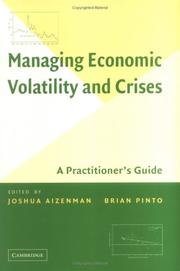| Listing 1 - 4 of 4 |
Sort by
|

ISBN: 9780511510755 9780521855242 9780521168595 0521855241 9780511139031 0511139039 0511140347 9780511140341 0511138288 9780511138287 0511140037 9780511140037 9780511140808 0511140800 9786610309030 6610309035 0511510756 0521168597 1107155290 1280309032 0511301006 9781107155299 9781280309038 9780511301001 Year: 2005 Publisher: Cambridge New York Cambridge University Press
Abstract | Keywords | Export | Availability | Bookmark
 Loading...
Loading...Choose an application
- Reference Manager
- EndNote
- RefWorks (Direct export to RefWorks)
Economic volatility has come into its own after being treated for decades as a secondary phenomenon in the business cycle literature. This evolution has been driven by the recognition that non-linearities, long buried by the economist's penchant for linearity, magnify the negative effects of volatility on long-run growth and inequality, especially in poor countries. This collection organizes empirical and policy results for economists and development policy practitioners into four parts: basic features, including the impact of volatility on growth and poverty; commodity price volatility; the financial sector's dual role as an absorber and amplifier of shocks; and the management and prevention of macroeconomic crises. The latter section includes a cross-country study, case studies on Argentina and Russia, and lessons from the debt default episodes of the 1980s and 1990s.
Business cycles. --- Financial crises. --- Economic development. --- Development, Economic --- Economic growth --- Growth, Economic --- Economic policy --- Economics --- Statics and dynamics (Social sciences) --- Development economics --- Resource curse --- Crashes, Financial --- Crises, Financial --- Financial crashes --- Financial panics --- Panics (Finance) --- Stock exchange crashes --- Stock market panics --- Crises --- Economic cycles --- Economic fluctuations --- Cycles --- Business, Economy and Management
Digital
Abstract | Keywords | Export | Availability | Bookmark
 Loading...
Loading...Choose an application
- Reference Manager
- EndNote
- RefWorks (Direct export to RefWorks)
Book
Year: 2005 Publisher: [Washington, D.C. : World Bank,
Abstract | Keywords | Export | Availability | Bookmark
 Loading...
Loading...Choose an application
- Reference Manager
- EndNote
- RefWorks (Direct export to RefWorks)
"Over the past 25 years, significant levels of public debt and external finance are more likely to have enhanced macroeconomic vulnerability than economic growth in developing countries. This applies not just to countries with a history of high inflation and past default, but also to those in East Asia, with a long tradition of prudent macroeconomic policies and rapid growth. The authors examine why with the help of a conceptual framework drawn from the growth, capital flows, and crisis literature for developing countries with access to the international capital markets (market access countries or MACs). They find that, while the chances of another generalized debt crisis have receded since the turbulence of the late 1990s, sovereign debt is indeed constraining growth in MACs, especially those with debt sustainability problems. Several prominent MACs have sought to address the debt and external finance problem by generating large primary fiscal surpluses, switching to flexible exchange rates, and reforming fiscal and financial institutions. Such country-led initiatives completely dominate attempts to overhaul the international financial architecture or launch new lending instruments, which have so far met with little success. While the initial results of the countries' initiatives have been encouraging, serious questions remain about the viability of the model of market-based external development finance. Beyond crisis resolution, which has received attention in the form of the sovereign debt restructuring mechanism, the international financial institutions may need to ramp up their role as providers of stable long-run development finance to MACs instead of exiting from them. "--World Bank web site.
Book
Year: 2005 Publisher: [Washington, D.C. : World Bank,
Abstract | Keywords | Export | Availability | Bookmark
 Loading...
Loading...Choose an application
- Reference Manager
- EndNote
- RefWorks (Direct export to RefWorks)
"Over the past 25 years, significant levels of public debt and external finance are more likely to have enhanced macroeconomic vulnerability than economic growth in developing countries. This applies not just to countries with a history of high inflation and past default, but also to those in East Asia, with a long tradition of prudent macroeconomic policies and rapid growth. The authors examine why with the help of a conceptual framework drawn from the growth, capital flows, and crisis literature for developing countries with access to the international capital markets (market access countries or MACs). They find that, while the chances of another generalized debt crisis have receded since the turbulence of the late 1990s, sovereign debt is indeed constraining growth in MACs, especially those with debt sustainability problems. Several prominent MACs have sought to address the debt and external finance problem by generating large primary fiscal surpluses, switching to flexible exchange rates, and reforming fiscal and financial institutions. Such country-led initiatives completely dominate attempts to overhaul the international financial architecture or launch new lending instruments, which have so far met with little success. While the initial results of the countries' initiatives have been encouraging, serious questions remain about the viability of the model of market-based external development finance. Beyond crisis resolution, which has received attention in the form of the sovereign debt restructuring mechanism, the international financial institutions may need to ramp up their role as providers of stable long-run development finance to MACs instead of exiting from them. "--World Bank web site.
| Listing 1 - 4 of 4 |
Sort by
|

 Search
Search Feedback
Feedback About UniCat
About UniCat  Help
Help News
News